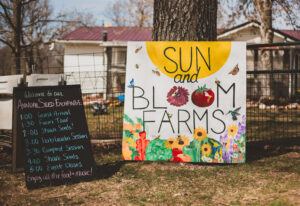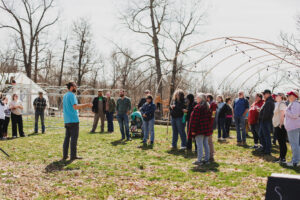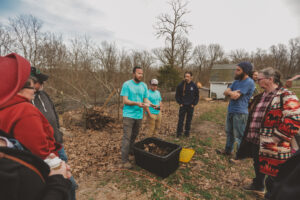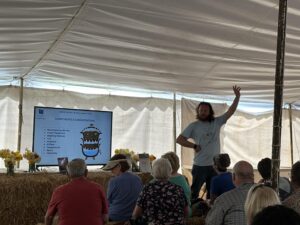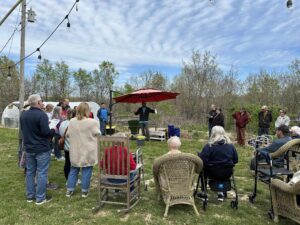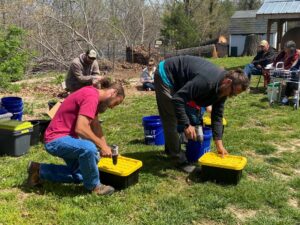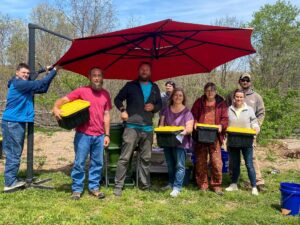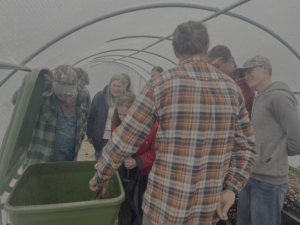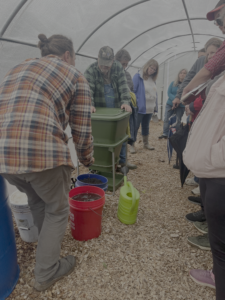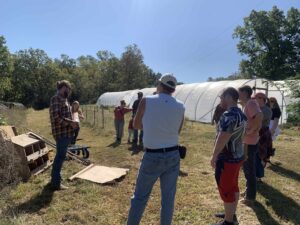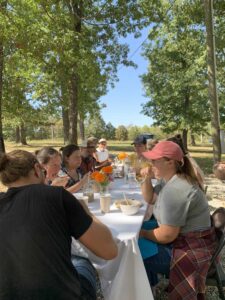Progress report for FNC24-1440
Project Information
Ionut Lucian Toma - Project Manager
- I have designed, developed and implemented sustainable agriculture and other sustainability related educational projects and programs for the past 10 years, including 3 years as a main educator and public programs director at a top regenerative agriculture educational non-profit in Southern California (The Ecology Center), 7 years as the main educator of permaculture courses and designer of edible landscapes for private and public spaces, and 8 years as the director of a local government Public Composting Education Program for the City of Carlsbad California. I also taught Horticulture courses at Community College level. High level and detailed project reporting, community outreach and public hands-on education have been big part of my work. I continue to use those skills since July 2023 as the Area Educator for the Lincoln University Horticulture Program - I get to meet and help a lot of vegetable farmers! I have also built and ran my current farm since 2021, part time with my partner Anna Maria Desipris with an average income generated of $10,000 per year from vegetable, herbs and flowers production, from less than 3/4 acre. I understand and have experience with vegetable production and regenerative soil management. I will manage and perform most of the activities in this project
Anna Maria Desipris - Project Management Support
- Anna Maria was part of a team who designed and managed some of the first large agri-hoods in Orange County California from 2012 to 2014. She also managed a 1 acre citrus orchard for the City of Irvine via a non-profit organization. For 4 years at The Ecology Center, she brought together top regenerative local farmers with 5 start chefs and led community tables with attendance between 20 to 200. She also taught Horticulture and Urban Farming course at the Community College Level. She has a deep understanding of vegetable, herbs and cut flower production. She will provide support with the management and performing of most of the activities in this project.
Our farm includes a 3/4 acre existing market garden where we grow veggies, herbs and flowers for local farmers markets and farm stands. We also have a 200 chickens for egg production operation and 7 dairy goats. We manage all operations with the help of 1 or 2 summer interns.
Many market garden farmers growing vegetables in our region are not taking advantage of the environmental, economic and human health benefits resulting from the use of natural / organic liquid fertilizers made on their own farms, such as vermicompost teas. As demonstrated by past SARE funded projects and a growing number of organic farming literature, safe, agriculturally effective and ecologically sustainable vermicompost and vermicompost teas are easy to produce and use on farms at various scales. Their use sustains healthy plant growth and yields highly nutrient rich vegetables and fruits that attract premium prices in the market, while also improving the soil. Farmers that do not produce and use vermicompost and vermicompost teas on their farms are missing out on short and long term cost savings and resilience in the face of growing costs of fertilizers and the maintenance of productive agricultural soils, as well as on capturing higher prices on healthier, more abundant and nutrient rich produce. Low adoption rates in our region of on-farm vermicompost and vermicompost tea production and use may be due tue a lack of accessible and well documented resources that depict the advantages and details of this practice in market gardens in our region.
Solution:
The Vermicompost and Vermicompost Tea Production Station
In a designated space in the vicinity of our existing ¾ acre market garden, we will build a mobile vermicompost production and liquid fertilizer making station. This station will be scaled to primarily serve the needs of this project, (production and demonstration purposes). The station will be a 16x24x9 high tunnel customized with environmental controls, including roll up sides, fans, a covering tarp and insect protection mesh. Inside, the station will contain the following:
- a custom built 10’x3’continuous flow-through (cft) vermicompost production bin with 50 pound maximum production capacity
- 3 55 gallon plastic drums with lids for storing the harvested vermicompost, for “brewing the aerated teas and mixing the organic liquid fertilizers,
- 4 different plastic toast with wheels to store the materials and equipment used in the project
- An area to store the commercially bought vermicompost
This is where the on-farm vermicompost will be produced, the 2 aerated teas will be brewed, (one from the vermicompost produced on the farm and one with the commercially bought vermicompost), and the organic liquid fertilizers will be mixed for regular soil drenches. All the materials, supplies and equipment for this project will be inside this station.
The trial plots
For this project we will use 3 similar test plots in our existing garden, one for each liquid fertilizer, growing the same plants at the same time. We will designate three (3) 30”x30’ rows per test plot, for a total of 9 rows. We will test carrots followed by beans and lettuce followed by peppers in the field and radishes followed by tomatoes in a high tunnel. Every row will have the same initial treatment: 2 to 3 inches of commercially bought organic compost.
The Operations
We will feed and harvest from the cft once per week. The feedstock will include mostly food and weed free garden waste as well as manure composted over 150F to make sure seeds are killed and avoid germination in our plots. The cft will be kept at SARE funded literature suggested temperature and humidity ranges and protected from insects, especially flies.
We will make and apply the liquid fertilizers every 2 weeks as a soil drench/soak with a watering can on each row. We will stop fertilizing leafy and root crops at least 1 week before their harvest date and fruiting crops after peak production (mid/late august).
We will use best literature suggestions, including SARE funded projects, for aerated tea “brewing”, organic fertilizer mixing and application quantities (approx. 20 gallons / acre)
We will document all of our actions and their effects, such as testing the soil ph and macronutrient contents, as well as biological activity via our existing microscope, every week. Once harvested, we will also send samples of the crops for nutrient density testing.
We will share our findings publicly once per month via video and blog posts on a project designated webpage and conduct a hands-on demonstration full day workshop for the local farmers for 2 years in a row.
Objectives
- Document the assembly and operations of a scalable,mobile, continuous flow-through (cft) vermicompost production bin and vermicompost tea production station for 2 growing seasons (pictures, videos, guide book style notes)
- Document and compare the costs, operations and production effects of the 3 liquid fertilization sources, including soil biology activity, plant growth rate, plant health and produce nutrient density. (pictures, videos, guide book style notes)
- Share the process and findings online via monthly vlog and blog entries during the 2 growing seasons
- Share the process and findings in-person via 1 annual on-farm workshop in 2 growing seasons
Cooperators
- - Producer
- - Producer
Research
On Farm Vermicompost Production and Use
The Infrastructure
The Vermicompost Production and Vermicompost Tea Brewing Station (Research Station):
- (Objective 1) In the first year we purchased the complete kit for the 16x24x9 High Tunnel, plus the tarp to create shade in the Research Station, we originally planned to purchase, however, because we were not able to install it till late may, we purchased an additional, easy to install smaller greenhouse for the first 3 months of the project, March, April and May - this proved to work great for almost the entire year as a secondary vermicompost production and brewing station that served other needs on the farm also, such as the seedlings production greenhouse - we learned that the location of the research station really matters, the closer to the fields, the easier it was for us to monitor it and use its production
- (Objective 1) Since the initial research station space was smaller, we decided to purchase an already made CFT system, to get the on-farm vermicompost production going. We went with 2 “Hungry Bin” CFTs that reduced our original 30 cubic feet vermicompost capacity to 26 (each Hungry bin has a 13 cubic feet capacity) - this system ended up working really well, since it had wheels and we were able to move it in a cooler spot a few times during the year, when the temperatures were very high, and we were able to bring it to different locations for the workshops we conducted
- (Objective 1) All the totes and barrel we planned to purchase initially for storage, and the “brewing” pump and bags fit really well in the initial space and were easy to transfer to the new research station - we had to purchase additional totes and pump to have it in both locations
- (Objective 1) Our initial calculations for how much vermicompost we needed to produce, and how much vermicompost to buy were right on point for the project; we only had to purchase additional liquid fertilizer for the project - we learned that the store bought liquid fertilizers were the most expensive, but the farm made vermicompost took the most time from a full circle process, make, harvest, brew, use, and therefore more costly from a time frame point of view (we believe we had a lot of operational inefficiencies in this 1st year, and have a new and improved plan for 2025)
The Process
- (Objective 2) We hired a farm apprentice to lead the weekly vermicompost feeding and harvest, as well as the biweekly vermicompost teas and fertilizer making and applications, plus all the documentation; they marked down how much the CFT was fed and how much it produced each week; they also marked down how much farm made and bought vermicompost was used, as well as the liquid fertilizer and how much of it was necessary for the research plots; we used the microscope to check the beneficial organisms count in the farm made versus the store bought vermicompost teas and a few times we looked and compared the count in the soil before and after the use of the 3 fertilization methods - unfortunately, we had to train the apprentice a lot, and remind to take the notes, and we had to do it ourselves many times, a lot of the data is missing, which tells us that we have to commit more time to the process ourselves (it looked like we gave the apprentice to many fertilizations tasks and they were not always able to differentiate the research tasks versus general farm tasks, due to time constraints - we hired a new apprentice for 2025 that will be designated just to the research portion of things)
- (Objective 2) We were able to observe some important plant growth rates and production volumes for all the crops we tested on, carrots, beans, lettuce, peppers and tomatoes. We were not able to send the crops for nutrient density testing in 2024 and we planned to do it in 2025 - all fertilizers performed very well, with the organic liquid fertilizers showing a faster growth rate and approximately 10% higher yields, the second best when it comes to growth rate and yields was the home made vermicompost, and overall, even if we did not have a nutrient density test done and was not able to test the nutrient quality of the yields thoroughly, both of the vermicompost grown test fields had “testier” produce according to some of the feedback we recorded randomly (we will put more focus on this in 2025); additionally, the soil testing we did a few times during the growing season showed that both of the plots where vermicompost was used had a minimal ph and nutrient swing, whereas the liquid organic treated field had regular ph swings of 1 point and fast depletion of Nitrogen especially; moreover, the vermicompost treated plots kept moisture for longer periods of time, and plants did not go “loopy” at all, while the organic fertilizer plot had dryness problems a few times during the very hot period of the year
- (Objective 4) We provided more than 1 On-farm Vermicompost Production and Use workshops on the farm, in fact we taught 4, one in March, one in April, one in June and one in October. We partnered with Lincoln University of Missouri Extension for 2 of them and with Missouri University Extension for one. We had a total of 40 gardeners and 18 farmers. We showed the production, tea brewing and use process - we learned that when we promised a free vermicompost starter bin and/or catered food, more people showed up
- (Objective 1, 2 & 3) We created simple fact and guide sheets as handouts for the workshops, and shared via social media posts and email newsletters on vermicompost production and vermicompost tea use. We were not able to follow a well scheduled share of our progress in 2024, and plan to in 2025 - we did notice a huge uptake in interest in our produce every time we shared about our researched and observed b benefits of growing produce with vermicompost
Overall
- The biggest in of the project was to visually see the difference between the 3 methods of fertilization, in growth rate (liquid fertilizers win), yields (liquid fertilizers win), vibrant colors / plant overall health / nicer looking and tastier produce (both vermicomposts win), soil and plant resilience to heat and pests (both vermicomposts win), soil microorganisms abundance (both vermicomposts win)
- We will make a few adjustments to our record keeping and knowledge sharing in 2025 to produce a more complete and helpful report for farmers
Results
All rows were 30”x 30’ and had 4 inches of OMRI Listed compost added to an existing garden soil
Field 1 - Farm Made Vermicompost - applied as “brewed” 24 hours aerated tea every 2 weeks
- Row 1 March 15 Through May 15 - Carrots (5 rows) - 135 LBS (fastest sprout)
- Row 1 May 15 Through August 15 - Beans (2 rows) - 40 LBS (fastest sprout)
- Row 2 March 15 Through May 15 - Lettuce (3 rows) - Romaine 99 LBS (fastest sprout)
- Row 2 May 15 Through August 15 - Pepper (1 row) - Sweet Green/Yellow/Red (15) - 92 LBS
- Row 3 March 15 Through May 15 - Radish (5 rows) x 2 - 135 LBS (fastest sprout)
- Row 3 May 15 Through August 15 - Tomatoes (1 row) - (15) 265 LBS (some leaf yellowing and some small fruits)
Field 2 - Store Bought OMRI Listed Vermicompost - applied as “brewed” 24 hours aerated tea every 2 weeks
- Row 1 March 15 Through May 15 - Carrots (5 rows) - 130 LBS
- Row 1 May 15 Through August 15 - Beans (2 rows) - 39 LBS
- Row 2 March 15 Through May 15 - Lettuce (3 rows) - Romaine 100 LBS
- Row 2 May 15 Through August 15 - Pepper (1 row) - Sweet Green/Yellow/Red (15) - 90 LBS
- Row 3 March 15 Through May 15 - Radish (5 rows) x 2 - 135 LBS
- Row 3 May 15 Through August 15 - Tomatoes (1 row) - (15) 255 LBS (lots of leaf yellowing and some small fruits)
Field 3 - Liquid Fertilizers OMRI Listed - 1-0-2 Kelp & 2-3-1 Fish after 2 true leaves out every 2 weeks - needed extra watering
- Row 1 March 15 Through May 15 - Carrots (5 rows) - 150 LBS (too much green leaves)
- Row 1 May 15 Through August 15 - Beans (2 rows) - 44 LBS (lots lost to bugs)
- Row 2 March 15 Through May 15 - Lettuce (3 rows) - Romaine 110 LBS
- Row 2 May 15 Through August 15 - Pepper (1 row) - Sweet Green/Yellow/Red (15) - 110 LBS (fastest leaf and stem growth)
- Row 3 March 15 Through May 15 - Radish (5 rows) x 2 - 120 LBS (too much green leaves)
- Row 3 May 15 Through August 15 - Tomatoes (1 row) - (15) 295 LBS (fastest leaf and stem growth)
Educational & Outreach Activities
Participation Summary:
Workshops - 51 gardeners and aspiring farmers, 22 farmers, 6 ag professionals
March - On Farm Composting Systems - Workshop - at Sun And Bloom Farms
- We partnered with Lincoln University of Missouri Extension office to provide this 5 hour workshop with lunch and breakfast refreshments.
- Vermicompost was about 1.5 hours of this workshop - we showed our system in action, had all interacted with harvesting the vermicompost, making aerated tea and using it in the garden
- 10 gardeners (aspiring farmers) and 6 farmers - everyone received multiple fact sheets and guide sheets on vermicomposting we produced both for this project and to serve other educational purposes
April - Farm Scale Vermicomposting Systems - Presentation - at Baker Creek Rare Seeds in Mansfield
- We partnered with Lincoln University of Missouri Extension office to provide this 2 hour presentation and demonstration at Baker Creek Tulip festival
- This included a research based presentation about the benefits of vermicompost in vegetable production and general farming, examples of vermicomposting systems, and how it can be used in vegetable production
- Over 100 people in the audience - 15 identified as local gardeners 4 identified as local farmers - - everyone received multiple fact sheets and guide sheets on vermicomposting we produced both for this project and to serve other educational purposes
May - Farm Scale Vermicomposting Systems - Workshop / Field Day - at Sun And Bloom Farms
- We partnered with Lincoln University of Missouri Extension office to provide this 2 hour tour and hands on workshop on how to set up a starting vermicompost production and tea system on a vegetable farm of our scale
- 11 (aspiring farmers) gardeners and 4 farmers - - everyone received multiple fact sheets and guide sheets on vermicomposting we produced for this project - farmers also received a small vermicompost system to start at their home
June - Farm Scale Vermicomposting Systems - Workshop / Field Day - at Sun And Bloom Farms
- We provided a tour and hands on workshop on how to set up a starting vermicompost production and tea system on a vegetable farm of our scale
- 10 (aspiring farmers) gardeners and 4 farmers - - everyone received multiple fact sheets and guide sheets on vermicomposting we produced for this project
October - Regenerative Market Gardening - Workshop / Field Day - at Sun And Bloom Farms
- We partnered with University of Missouri Extension office to provide this 5 hour workshop with lunch and breakfast refreshments.
- Vermicompost was about 1.5 hours of this workshop - we showed our system in action, had all interacted with harvesting the vermicompost, making aerated tea and using it in the market garden
- 5 gardeners, 4 farmers and 6 ag professionals - everyone received multiple fact sheets and guide sheets on vermicomposting we produced for this project
We plan to start a monthly online webinar presentation or edited video release in April 2025 and run 3 or 4 more workshops targeting aspiring and existing market vegetable growers.
Vermicompost Small Scale Systems - Guide Sheet
Vermicompost - Benefits, Systems, Uses, Sales - Presentation
